Scientists Dissect Remarkably Well-Preserved Baby Mammoth From Ice Age

Sarah Johnson
April 18, 2025
Brief
Russian scientists dissected a remarkably well-preserved, 130,000-year-old baby mammoth named Yana, revealing insights into Ice Age life and prehistoric anatomy.
Warning: This article contains graphic pictures. Reader discretion is advised.
Russian scientists recently undertook the delicate dissection of a female baby mammoth, nicknamed "Yana," whose frozen remains date back more than 130,000 years. The mammoth was excavated from permafrost in the Yakutia region and studied at North-Eastern Federal University in Yakutsk on March 27.
Weighing nearly 400 pounds, Yana bears a striking resemblance to modern baby elephants. Photographs from the necropsy reveal the creature with its mouth open and trunk curled as scientists carefully cut through her skin to study the ancient anatomy.
Initial estimates dated Yana to around 50,000 years ago, but further analysis of the surrounding permafrost layers extended her age to over 130,000 years, plunging her existence deep into the Ice Age era.
Maxim Cherpasov, leading the Lazarev Mammoth Museum Laboratory, explained that the mammoth was just over a year old when she died. Unfortunately, predators had already started feasting on the carcass before its discovery. "The parts that thaw first, like the trunk, are often targeted by modern animals or birds," Cherpasov noted, pointing out that while much of the forelimbs were consumed, the head remained amazingly preserved.
Though rare, discoveries of well-preserved mammoth remains pop up occasionally. Just last year, a fisherman along Poland's Raba River found a massive mammoth bone, while a collector in Mississippi uncovered part of a Columbian mammoth tusk.
These finds not only offer tantalizing glimpses into prehistoric life but also challenge scientists to piece together the mysteries frozen in time beneath icy layers.
Topics
Editor's Comments
A baby mammoth thawing out after 130,000 years is like nature's version of the ultimate 'cryogenic baby'—all grown up in twenty centuries. Even after all that time, Yana’s story shows how life, and death, leave captivating footprints that refuse to fade quietly away.
Like this article? Share it with your friends!
If you find this article interesting, feel free to share it with your friends!
Thank you for your support! Sharing is the greatest encouragement for us.



